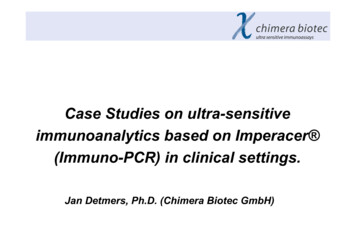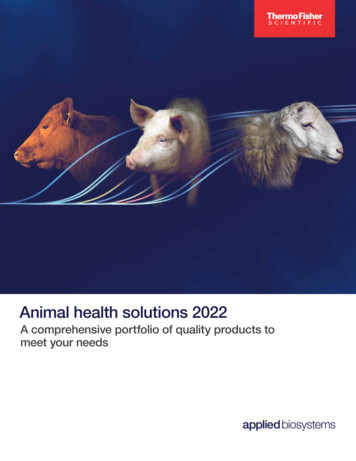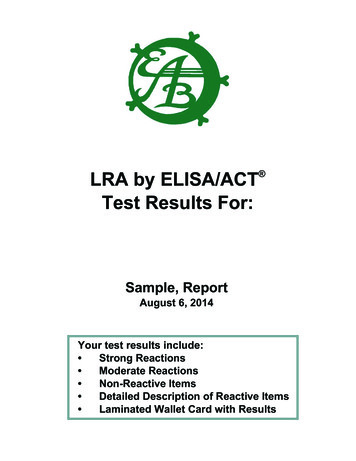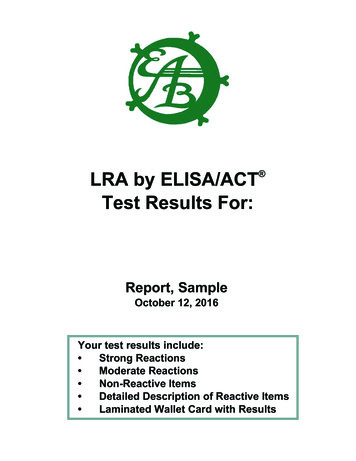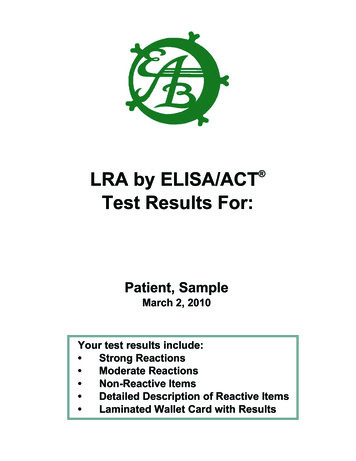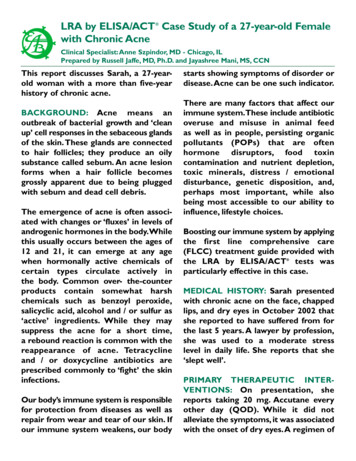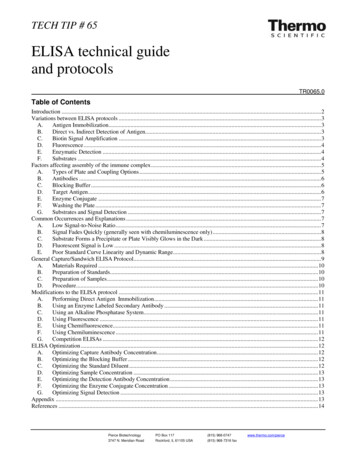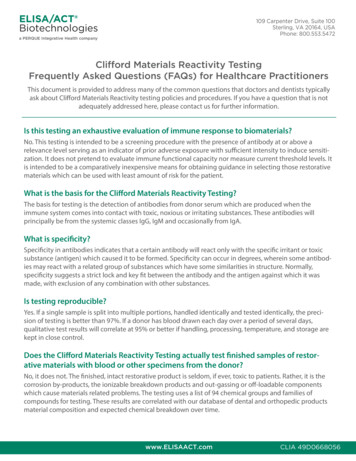
Transcription
ELISA/ACT Biotechnologies109 Carpenter Drive, Suite 100Sterling, VA 20164, USAPhone: 800.553.5472a PERQUE Integrative Health companyClifford Materials Reactivity TestingFrequently Asked Questions (FAQs) for Healthcare PractitionersThis document is provided to address many of the common questions that doctors and dentists typicallyask about Clifford Materials Reactivity testing policies and procedures. If you have a question that is notadequately addressed here, please contact us for further information.Is this testing an exhaustive evaluation of immune response to biomaterials?No. This testing is intended to be a screening procedure with the presence of antibody at or above arelevance level serving as an indicator of prior adverse exposure with sufficient intensity to induce sensitization. It does not pretend to evaluate immune functional capacity nor measure current threshold levels. Itis intended to be a comparatively inexpensive means for obtaining guidance in selecting those restorativematerials which can be used with least amount of risk for the patient.What is the basis for the Clifford Materials Reactivity Testing?The basis for testing is the detection of antibodies from donor serum which are produced when theimmune system comes into contact with toxic, noxious or irritating substances. These antibodies willprincipally be from the systemic classes IgG, IgM and occasionally from IgA.What is specificity?Specificity in antibodies indicates that a certain antibody will react only with the specific irritant or toxicsubstance (antigen) which caused it to be formed. Specificity can occur in degrees, wherein some antibodies may react with a related group of substances which have some similarities in structure. Normally,specificity suggests a strict lock and key fit between the antibody and the antigen against which it wasmade, with exclusion of any combination with other substances.Is testing reproducible?Yes. If a single sample is split into multiple portions, handled identically and tested identically, the precision of testing is better than 97%. If a donor has blood drawn each day over a period of several days,qualitative test results will correlate at 95% or better if handling, processing, temperature, and storage arekept in close control.Does the Clifford Materials Reactivity Testing actually test finished samples of restorative materials with blood or other specimens from the donor?No, it does not. The finished, intact restorative product is seldom, if ever, toxic to patients. Rather, it is thecorrosion by-products, the ionizable breakdown products and out-gassing or off-loadable componentswhich cause materials related problems. The testing uses a list of 94 chemical groups and families ofcompounds for testing. These results are correlated with our database of dental and orthopedic productsmaterial composition and expected chemical breakdown over time.www.ELISAACT.comCLIA 49D0668056
ELISA/ACT Biotechnologies109 Carpenter Drive, Suite 100Sterling, VA 20164, USAPhone: 800.553.5472a PERQUE Integrative Health companyHow is specificity shown?Specificity in this type of testing is demonstrated by showing that globulin in a donor specimen can reactwith a certain quantity of a single challenge such as mercury salts, aluminum salts, acrylate compounds,etc. After the resulting precipitate or formed combination is centrifuged out, the remaining globulin willnot react further by adding more of this single challenge. The precipitate or product can be shown tocontain principally the target challenge material and globulin. When a second single challenge is added tothe serum specimen, however, a new quantity of precipitate or combination product is formed. If separated out, this second precipitate or combination contains principally the second single challenge substanceand globulin. Adding more of the second challenge to the serum specimen produces no more reaction.The serum specimen can be shown to contain remaining globulin, meaning that the steps of adding twochallenge materials and removing their reaction products did not simply remove all globulin and proteinindiscriminately from the serum. If a third challenge is added, the same observations prevail as with theprevious two challenges. This assumes that the donor has a sensitization to all three challenge materials.Even after removing the products of the third challenge, there will be remaining globulin in the test serumsupernatant fluid. The challenges removed only that globulin (antibody) which was specifically producedagainst the challenge in question.Does the order in which the challenges are presented make any difference?No. We have demonstrated that sequence is inconsequential using aluminum, copper and mercury salts asthe challenge materials. The only qualification is that the donor must be sensitized and have demonstratedantibody titers for each challenge.Can you stop the formation of precipitates altogether other than by adding challenges?Yes. A simple technique of precipitating proteins generally and non-specifically from the serum by addingammonium sulfate renders the specimen incapable of forming further precipitates with any of the challenge materials. Supernatant serum fluids treated in this manner will have virtually no albumin or globulinwhen analyzed by serum chemistry test methods.Can a combination of antigen and antibody be demonstrated by any other meansexcept simple precipitation in a tube?Yes. When wells are prepared in an agar test plate such that serum can be placed in a central well andchallenge solutions are placed individually in outer surrounding wells, the formation of precipitin bandsbetween the serum and challenge wells are observed in 18-24 hours. If challenges are mixed together in asingle well and allowed to diffuse out into the agar towards the serum test well, multiple precipitin bandsare seen routinely. This general technique is referred to as an Ouchterlony double gel diffusion.Have any other methods been used that suggest the reactions being observed are antigen and antibody-based activities?Yes. In addition to general liquid precipitation and Ouchterlony double diffusion techniques, the latexagglutination technique and sheep red cell hemagglutination inhibition method have been successfullyused for testing purposes.Page 2www.ELISAACT.comCLIA 49D0668056
ELISA/ACT Biotechnologies109 Carpenter Drive, Suite 100Sterling, VA 20164, USAPhone: 800.553.5472a PERQUE Integrative Health companyWhy are these other methods not routinely used along with the precipitin method?Our studies have shown that each of the four mentioned methods give similar results. They have showngood cross-checking on each other. The precipitin method is by far the most simple and straight-forwardto carry out. As a matter of logistics, timely reporting and cost to patient, we have found that the precipitinmethod is reliable, stable and well suited to a screening procedure.What equipment is used for the precipitin evaluation?The testing is completed in a microtiter environment. Reading is performed on a multiple wavelengthphotometric scanner. After the machine has used two wavelengths to determine density, the final evaluation of the plate is made by visual inspection by experienced personnel to help in differentiating betweena true precipitin reaction and certain non-specific agglutinations which can sometimes occur simply bymixing chemicals with serum in the presence of air.Can't the photometric scanner do better than a human eye?Yes and No. The photometric scanner can evaluate density measurements with very fine gradations andprecision which are not possible by visual inspection. We use the scanner to obtain fundamental densityreadings for all specimens. These readings are captured by computer and electronically processed toreduce the likelihood of human transcription and judgemental errors. However, simple density is not theonly important evaluation which must be made. For example, it is also important to know that we areevaluating a precipitin reaction and not a simple non-specific agglutination of serum protein which canoccur when certain chemicals are mixed with serum out in the air. Evaluation of granularity can easily bemade by a trained eye. Sometimes, light can be refracted and diverge into a split spectrum which results inan opalescent appearance, especially near the boundaries of the specimen. This quality is also bestobserved by eye, and helps to insure that we are evaluating a true precipitin reaction. Thus, we will examine test specimens by trained eye after they are photometrically evaluated by a high-qualitystate-of-the-art scanner. The use of both machine and visual evaluation helps us insure a higher level ofquality in the evaluation of patient specimens and helps substantially reduce the incidence of reportingfalse positive data which could result if the scanner is used by itself.Why don't you routinely quantify with end-point titrations?There is no useful reason to do so. Such measurement might be academically satisfying, but no additionalclinical indications would result. The amount of antibody present will indicate something about currencyand quality of exposure, but can change and will drop if no further challenge is presented. There is no validcorrelation between amount of antibody present and degree of sensitivity in the donor. End-point titrationcould cause the price of testing to rise into the 1500- 2000 range, and the result would still suggest nomore than sensitivity exists in the donor.Can the testing prove that existing fillings are the cause of sensitization?No, it cannot. Systemic sensitization can come from a variety of sources, including food, water, environment and lifestyle. Existing fillings may be involved or may contribute to sensitization, but the testingcannot demonstrate the specific relationship. The dentist or physician, with proper examination andPage 3www.ELISAACT.comCLIA 49D0668056
ELISA/ACT Biotechnologies109 Carpenter Drive, Suite 100Sterling, VA 20164, USAPhone: 800.553.5472a PERQUE Integrative Health companyclinical judgment, may determine that the fillings already in place are well-corroded and show signs ofmargin leakage, etc. On the basis of clinical judgment, together with test findings, the professional maysuggest that replacement would be desirable. The testing, however, cannot serve as "proof" that existingdental restorations are the sole or primary factors in sensitization.How do you know that you are actually detecting antibodies, and not just observingsome general precipitation of serum proteins?The testing has successfully demonstrated both specificity and reproducibility of results using multipleantibody detection methods. The precipitates and residues from the various methods contain both thetarget substance (antigen) and globulin (antibody protein). What happens if the donor is sensitive to onlytwo of the three challenges? From our work, there will be no precipitate formed with the challenge forwhich there is no sensitivity.How do you know that globulin or other protein remains in the supernatant fluids afterprecipitates or reaction combinations are formed with challenge materials?Supernatant fluids have been shown to contain both albumin and globulin using simple serum chemistrytest methods. The quantity of globulin reduces after each challenge is added and the precipitate isremoved but does not completely disappear. Albumin may vary slightly but does not alter materially.Does testing ever have false positive findings?Yes. False positive findings are believed to occur generally when antibodies against one kind of challengelack complete specificity and cross react with certain other challenges. These cross reactions in testing arenot necessarily bad in that the same cross-reactivity may well occur in-vivo. Frequency rate for cross reactivity is believed to be less than 5% of findings. An example of antibodies which frequently cross react arethose which act with cadmium and beryllium.Does testing ever have false negative findings?Yes. Most false negative findings are believed to occur when sensitization occurs, but residual antibodylevels fall below test detection limits. A patient may have the capacity to react very strongly when newchallenge is introduced, and antibody levels can rise very rapidly. If there is not sufficient antibody todetect, testing will miss the sensitivity. In certain patients, sometimes referred to as universal or environmental reactors, sensitivity may occur at a cellular contact level and never stimulate an immune defense. Inthese patients, there may not be any antibody production to detect, even though reactivity is a problem.Patients who have been on long-term immuno-suppressive treatments such as with corticosteroids mayhave abnormal suppression of antibody levels and may not be good candidates for this kind of testing.Based upon clinical feedback, the occurrence of false negatives is believed to be a very infrequent factor inpatient treatment protocols. If false positives and false negatives can occur, why bother with testing at all?The value of testing is to screen and identify substances which should be avoided and to identify productswhich can be used with least degree of risk. Testing cannot remove all of the risk. Although infrequent,based upon clinical feedback and experimental longitudinal test series, there is always the potential fornew, de novo sensitivities to occur. However, those products which do show as contraindicated havePage 4www.ELISAACT.comCLIA 49D0668056
ELISA/ACT Biotechnologies109 Carpenter Drive, Suite 100Sterling, VA 20164, USAPhone: 800.553.5472a PERQUE Integrative Health companydefinite basis to be avoided, and the risk factors in treatment are materially reduced by identifying thoseproducts. As testing is further refined with time, the risk levels may be reduced even further.Can metals really be considered an adequate antigen?In most cases, metals will serve as a very valuable part of the antigen referred to as a hapten. There is goodindication in published data that metals can fill such a role. Specificity studies at our own bench seem toconfirm this. Some of the light metals such as sodium, potassium and magnesium are not suitable. It islikely that in the antibody stimulation process, most metals will be bound to proteins, ligands, saccharidesand other carriers. They are quite capable of affecting the templating for antibody production.Do antibiotics or vitamin supplements adversely affect testing results?No, they do not. Long-term corticosteroid usage or other immuno-suppressive treatments may have anadverse effect by depressing antibody levels or altering their ability to function normally. We are not awareof any such interference by antibiotics, vitamin or mineral supplements, thyroid supplements, diuretics,etc. If a practitioner or patient determines that they will cease medications prescribed for patient use bycompetent health professionals, please be sure to inform the prescribing professional in advance of cessation and ensure that the patient knows those which can be instantly stopped and those which must bereduced gradually. Even immunosuppressive substance cessation may require complete clearance for upto 90 days before immune competence is reasonably normal again. Some patients will not be able to makesuch cessations safely and should be properly warned and counseled against taking their own unilateralactions.Do these antibodies represent a direct measurement of how much offending substancewas taken into the donor or which now resides in the donor's body?No, they do not. Antibodies are produced in response to a challenge to the immune system with an offensive substance (antigen). Depending on location within the body, binding site affinity, amount of absorption, bioavailability and elimination rate, the amount of antibody (titer) present is not necessarily proportional to either body burden or total exposure.Do these antibodies indicate how sensitive the donor is to the offending substance?No, they do not. They are used only as an indicator system of adverse exposure and resulting systemicsensitization. Sensitivity determination from antibody presence is a fundamental "yes / no" issue.If a large quantity (high titer) of antibody is found, doesn't this mean the donor is highlysensitive?No, it does not. High titers (or strongly reactive findings) of antibody may indicate a current or recent,high-quality exposure to the offending substance. If there is no continuing quality exposure, the quantity(titer) of antibody can fall even though there is an existing sensitivity programmed into cells such as thememory lymphocytes. A low titer (or weakly reactive finding) suggests either an extended period of timesince last exposure to the offending material, a poor quality in the antigen (offending substance), or thepossible onset of immune tolerance.Page 5www.ELISAACT.comCLIA 49D0668056
ELISA/ACT Biotechnologies109 Carpenter Drive, Suite 100Sterling, VA 20164, USAPhone: 800.553.5472a PERQUE Integrative Health companyCan antibody levels (titers) rise and fall, or change over time?Yes, they can. A continuing exposure to the offensive substance (antigen) may keep titers at higher levels,while absence of exposure may permit levels (titers) of antibodies to fall. The immune system may alsoestablish a tolerance for the offending substance over time, in which the toxicity to body physiology doesnot change but the immune system’s ability or inclination to fight the substance drops.Does testing prove that existing fillings need to be removed?No, for the same reasons cited above. Only clinical judgement can place test findings in the proper lightand evaluate replacement needs.How do you know that these bands are antigen and antibody combinations?We have excised the bands from agar plates after 24 hours for testing. Each band contains principally itstarget challenge and globulin. There is relatively good isolation between the bands and concentrations oftarget challenge substance will average two orders of magnitude greater concentration than for otherchallenges included in the mixtures if challenges were mixed prior to diffusion.Can the amount of antibody present be quantified?Yes. In our studies, we have experimentally performed endpoint titrations, which are an acceptable meansof quantifying antibody when a known concentration of challenge is used. A typical result might indicatethat a certain challenge titers out to 1:256.What patient symptoms prove correlation between sensitization and pathology?There are few set correlations of symptoms and toxicity in medicine. When tainted food containing certainendo and exotoxins from Clostridium perfringens or from Staphylococcus aureus is ingested, patients mayhave nausea, vomiting, headache, stomach cramps, diarrhea, esophageal reflux, gas, joint pains,light-headedness, insomnia, tachycardia, tetany, fever, edema, depression and sweats to name a few of thesymptoms. Not every patient will have every symptom, and intensity of reaction will usually vary throughout the affected population. Some individuals will have little or no difficulty at all. Toxic responses as wellas the formation of antigen-antibody complexes in vivo seldom have identical epidemiological presentations in the population and are clearly threshold based. Toxicity and the formation of immune complexesin vivo from restoratives breakdown fall into the same gamut of considerations.Does sensitivity found in this testing correlate to hair testing results for presence ofheavy metals?Sometimes, but not always. Presence of heavy metals does not necessarily prove toxicity or physiologicalinterference. Alternative pathways, genetic predispositions and individual threshold levels may permit arelatively high body burden of certain toxic substances to accumulate without any outward sign of impairment. Body burden alone should not be taken as an absolute indication of poisoning. Obviously, reductionof known toxic substances in the body burden cannot be taken as useless even in the absence of symptoms.Page 6www.ELISAACT.comCLIA 49D0668056
ELISA/ACT Biotechnologies109 Carpenter Drive, Suite 100Sterling, VA 20164, USAPhone: 800.553.5472a PERQUE Integrative Health companyDoes this testing correlate with other avenues of evaluation such as electrodermal,kinesiologic and radionic methods?Frequently, yes. There may occasionally be some subtle differences. When evaluations of any kind areperformed using samples of finished dental products as the reference point, there may be differencesbetween such finished products and the breakdown or corrosion byproduct forms of these products.When multiple avenues of evaluation are available, if any one method indicates a problem with a certainproduct, it probably should be removed from further consideration even if other methodologies do notpick up on the same contraindication. Each method offers certain strengths and certain weaknesses.When a patient is shown by Clifford Materials Reactivity Testing to have a sensitivity toaluminum salts, why are products containing aluminosilicates not routinely contraindicated?It is not the absolute content of the restorative product, but rather the ionizability or dissociability ofthings like aluminum to exit the restorative that make a difference. The half-life of an aluminosilicate (ameasure of its ability to break down and give off half of its individual components) is conservatively in thehundreds of thousands of years for conditions of the oral cavity, and in practice is probably much longer.For this reason, even the most severely aluminum-sensitive patients can safely use a drinking glass fromthe kitchen or have contact with sand on the seashore (both aluminosilicates). To be toxic, the aluminummust be ionized and offloaded from the restorative and then bound to available carriers. Some dentalproducts will use various forms of aluminum compounds for purposes of radiopaqueness, luster andlucency, pigmenting and texturing. These aluminum addition forms can often dissociate, and are of muchgreater concern. Contraindication of a product due to content of things like aluminum is based upondissociability rather than absolute content.Why do some insurance carriers not cover testing?Our testing is intended for dental application and is clearly outside of the policy provisions which are heldby some patients. Some carriers do not pay unless the majority of health practitioners within a given areause the testing. We know that some carriers do reimburse their policy holders according to policy provisions when proper procedural codes and diagnosis codes are supplied. ELISA/ACT Biotechnologies hascurrent industry standard procedural codes (CPT codes) and provides them on every receipt. Only a physician or dentist can render a diagnosis of patient conditions. In a substantial number of insurance denials, adiagnosis code (ICD-10 code) from the doctor is either lacking or not properly supported. On a morepositive note, an increasing number of insurance carriers are participating within the conditions of theirpolicies for testing. A current ICD-10 codebook can be obtained from the publications and book resaledivision of the American Medical Association.Why don't you publish a complete listing of all dental products and their componentparts and combined testing rankings?For several reasons: Some companies who make restorative products have been very forthright in sharingproprietary data with ELISA/ACT Biotechnologies on condition that we respect and protect the confi-Page 7www.ELISAACT.comCLIA 49D0668056
ELISA/ACT Biotechnologies109 Carpenter Drive, Suite 100Sterling, VA 20164, USAPhone: 800.553.5472a PERQUE Integrative Health companydence. Companies are not required to completely reveal everything about their products under currentgovernment regulation, and may alter their formularies from time to time without notifying anyone.ELISA/ACT Biotechnologies does not wish to take responsibility for becoming a public clearinghouse forproduct information, nor does it have the right to do so. When someone wants to know what is containedin "product X", we simply suggest they contact the manufacturer's public relations department andinquire. This permits the company the option to say whatever they choose about their own products.Page 8www.ELISAACT.comCLIA 49D0668056
ELISA/ACT Biotechnologies a PERQUE Integrative Health company clinical judgment, may determine that the llings already in place are well-corroded and show signs of margin leakage, etc. On the basis of clinical judgment, together with test ndings, the professional may suggest that replacement would be desirable.
